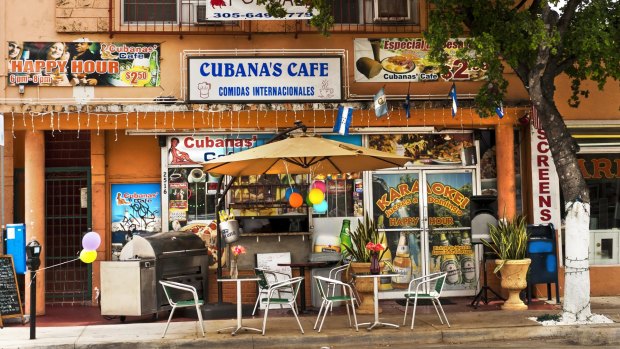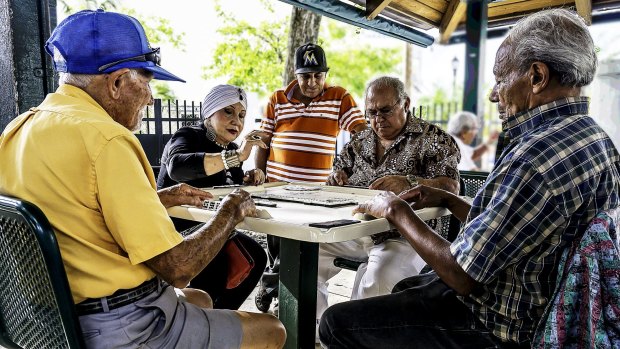This was published 4 years ago
Little Havana, Miami, US: A vivid glimpse into old pre-Castro Cuba
By Steve Meacham

Cubanas Cafe, a typical Cuban and Latin American restaurant in famous Calle Ocho, heart of Little Havana, where you can have lunch, sing karaoke and drink Cuban coffee.Credit: iStock
Fidel (not his real name, more on which shortly) greets our group at the Cubaocho Museum and Arts Centre, in Miami's Little Havana district.
The "museum" is a unique space that tells the story of Cuba through rotating art exhibitions and music performances. Its interior is breathtaking and includes a working bar with a colossal rum collection, and furniture that is also historically apposite.
Dayana, our guide on this Urban Adventures tour of Miami's Little Cuba, is a new Cuban arrival to Miami.

Locals playing a board game in Little Havana, Miami.Credit: iStock
Now 29, she arrived (legally) on Nov 8, 2016, the day Donald Trump became President-elect. Had she arrived two months later, she'd have been an illegal immigrant.
Fidel, she explains, had it far tougher.
Persecuted for his sexuality, Fidel fled Castro's Cuba and found a permanent home in Miami's Little Havana.
Today, Miami has the largest concentration of Cuban immigrants in the world: about three million, which is roughly the population of Havana.
In the years following Fidel Castro's communist 1959 revolution, two brothers brought two large oil paintings with them to Miami in their handcrafted boat. They had been given the paintings in payment for past debts, but neither brother knew their value.
"One was this, La Rumba," Dayana explains, pointing to a large canvas next to Cubaocho's nightclub stage. "I love it because it combines the mixture of African and Spanish influences that made Cuba."
"The other, El Saxofonista [by Carlos Sobrino, 1953, is far too valuable to put in front of a crowd drinking mojitos and dancing the samba."
The brothers prospered in Miami, building their homage to a Cuba long gone.
That's what you'll get in Little Havana: a few blocks still dominated by what pre-Castro Cuba used to be (without the heritage American cars).
Our second stop is a shop selling the classic four-pocketed Guayabera Cubana shirt.
Next, we meet Karen (who left Cuba 35 years ago). She shows us around one of Miami's most bespoke traditional cigar factories, Havana Classic (havanaclassic.com).
Americans are still banned from importing - or smoking - cigars made in Cuba. But some of the island nation's best cigar makers now live in Miami.
The tobacco is grown, from Cuban seeds, in the Dominican Republic. Roberto (the only male cigar roller) was trained in Cuba by Cohiba, and produces one of the finest Cohiban replicas outside "Big" Havana.
Karen shows us the virgin tobacco leaves ("each one is like a baby"), the humidor and the smoke room.
Next, we visit La Negra Francisca, selling both Catholic statues and the iconography of west African "voodoo" beliefs brought to Cuba during the slave trade.
"That's the history part of the tour over," Dayana tells us. "When we cross the street, it's the eating part." She's teasing, of course.
By crossing the street, we come to the tree-lined Memorial Boulevard which celebrates Cuban life in Miami.
The first monument records the ill-fated Bay of Pigs invasion of Castro's Cuba by Kennedy's presidency in April 1961. "Fourteen thousand Cuban exiles fought in that battle to overturn Castro," Dayana reminds us.
Memorial Boulevard is dominated by a huge Ceiba tree, sacred to Cuban believers of the west African gods, and a large map of Cuba.
Returning to Eighth Street, we enter Gullermina's Fruteria.
Gullermina herself serves us. She arrived in the US when she was 16 in the so-called Peter Pan Operation during which 14,000 Cuban children were flown to the US without their parents in an effort to "save the children" after Castro's revolution.
Even after all these years she speaks no English, yet she's maintained one of Little Havana's most authentic enterprises on a key street corner.
The avocadosshe sells in her greengrocery, grown in Florida from Cuban seeds, are the size of your average lawn bowl.
Most tourists, however, come for her concoctions made with sugar cane. Do try the sugar cane with ginger.
Many of the children who came over under the Peter Pan Operation "never saw their parents again," Dayana says.
Next, we visit Yisel bakery where chicken empanadas, guava pastelitos and proper Cuban coffee can be found. At Old's Havana restaurant you can get a genuine Cuban sandwich accompanied by live music. At the national heritage-listed dominoes park, expatriate Cubans play a game even more popular than baseball. Our final mojito stop is at Ball & Chain, which Dayana confesses is a favourite off-duty hang-out.
But it's hard to go past Gullermina's story.
TRIP NOTES
MORE
TOUR
Urban Adventures' Little Havana Adventure tours run for two hours and cost $US59. See urbanadventures.com
CRUISE
Regent Seven Seas Cruises has numerous cruise itineraries that visit Miami. See rssc.com
Steve Meacham travelled to the US as a guest of Regent Seven Seas Cruises and toured at his own expense. .
Sign up for the Traveller Deals newsletter
Get exclusive travel deals delivered straight to your inbox. Sign up now.